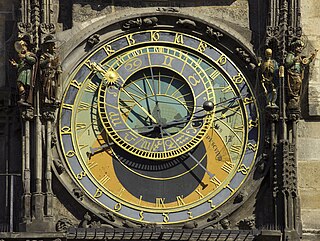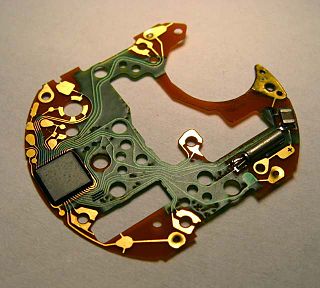
A pulsar clock is a clock which depends on counting radio pulses emitted by pulsars.

A pulsar clock is a clock which depends on counting radio pulses emitted by pulsars.
The first pulsar clock in the world was installed in St Catherine's Church, Gdańsk, Poland, in 2011. [1] It was the first clock to count the time using a signal source outside the Solar System, and represents the second type of clock to measure time using a signal source outside the Earth, after sundials. The pulsar clock consists of a radiotelescope with 16 antennas, which receive signals from six designated pulsars. Digital processing of the pulsar signals is done by an FPGA device. [2]
On October 5, 2011, a display showing the exact time of the pulsar clock, as a repeater of Gdańsk's pulsar clock, was installed in the European Parliament in Brussels, Belgium. [3]

A logic analyzer is an electronic instrument that captures and displays multiple logic signals from a digital system or digital circuit. A logic analyzer may convert the captured data into timing diagrams, protocol decodes, state machine traces, opcodes, or may correlate opcodes with source-level software. Logic analyzers have advanced triggering capabilities, and are useful when a user needs to see the timing relationships between many signals in a digital system.

Pomeranian Voivodeship is a voivodeship, or province, in northwestern Poland. The provincial capital is Gdańsk.
Time and frequency transfer is a scheme where multiple sites share a precise reference time or frequency. The technique is commonly used for creating and distributing standard time scales such as International Atomic Time (TAI). Time transfer solves problems such as astronomical observatories correlating observed flashes or other phenomena with each other, as well as cell phone towers coordinating handoffs as a phone moves from one cell to another.

A radio clock or radio-controlled clock (RCC), and often colloquially referred to as an "atomic clock", is a type of quartz clock or watch that is automatically synchronized to a time code transmitted by a radio transmitter connected to a time standard such as an atomic clock. Such a clock may be synchronized to the time sent by a single transmitter, such as many national or regional time transmitters, or may use the multiple transmitters used by satellite navigation systems such as Global Positioning System. Such systems may be used to automatically set clocks or for any purpose where accurate time is needed. Radio clocks may include any feature available for a clock, such as alarm function, display of ambient temperature and humidity, broadcast radio reception, etc.

DCF77 is a German longwave time signal and standard-frequency radio station. It started service as a standard-frequency station on 1 January 1959. In June 1973 date and time information was added. Its primary and backup transmitter are located at 50°0′56″N9°00′39″E in Mainflingen, about 25 km (20 mi) south-east of Frankfurt am Main, Germany. The transmitter generates a nominal power of 50 kW, of which about 30 to 35 kW can be radiated via a T-antenna.

A real-time clock (RTC) is an electronic device that measures the passage of time.

An astronomical clock, horologium, or orloj is a clock with special mechanisms and dials to display astronomical information, such as the relative positions of the Sun, Moon, zodiacal constellations, and sometimes major planets.

A time ball or timeball is a time-signalling device. It consists of a large, painted wooden or metal ball that is dropped at a predetermined time, principally to enable navigators aboard ships offshore to verify the setting of their marine chronometers. Accurate timekeeping is essential to the determination of longitude at sea.

PSR B1919+21 is a pulsar with a period of 1.3373 seconds and a pulse width of 0.04 seconds. Discovered by Jocelyn Bell Burnell on 28 November 1967, it is the first discovered radio pulsar. The power and regularity of the signals were briefly thought to resemble an extraterrestrial beacon, leading the source to be nicknamed LGM, later LGM-1.

Einstein@Home is a volunteer computing project that searches for signals from spinning neutron stars in data from gravitational-wave detectors, from large radio telescopes, and from a gamma-ray telescope. Neutron stars are detected by their pulsed radio and gamma-ray emission as radio and/or gamma-ray pulsars. They also might be observable as continuous gravitational wave sources if they are rapidly spinning and non-axisymmetrically deformed. The project was officially launched on 19 February 2005 as part of the American Physical Society's contribution to the World Year of Physics 2005 event.

A pulsar is a highly magnetized rotating neutron star that emits beams of electromagnetic radiation out of its magnetic poles. This radiation can be observed only when a beam of emission is pointing toward Earth, and is responsible for the pulsed appearance of emission. Neutron stars are very dense and have short, regular rotational periods. This produces a very precise interval between pulses that ranges from milliseconds to seconds for an individual pulsar. Pulsars are one of the candidates for the source of ultra-high-energy cosmic rays.

A millisecond pulsar (MSP) is a pulsar with a rotational period less than about 10 milliseconds. Millisecond pulsars have been detected in radio, X-ray, and gamma ray portions of the electromagnetic spectrum. The leading hypothesis for the origin of millisecond pulsars is that they are old, rapidly rotating neutron stars that have been spun up or "recycled" through accretion of matter from a companion star in a close binary system. For this reason, millisecond pulsars are sometimes called recycled pulsars.

A digital clock displays the time digitally, as opposed to an analogue clock.
PKP Szybka Kolej Miejska w Trójmieście Sp. z o.o. ; approximate English translation Tricity Rapid Transit Rail Ltd., usually abbreviated SKM, is a public rapid transit and commuter rail system in Poland's Tricity area, in addition reaching out to Lębork, Kartuzy and Koscierzyna; its service extended in the past also to Słupsk, Pruszcz Gdański, Tczew, Elbląg, or even as far as to Iława.

The Shepherd Gate Clock is mounted on the wall outside the gate of the Royal Observatory, Greenwich building in Greenwich, Greater London. The clock, an early example of an electrically connected clock system, was a sympathetic clock mechanism controlled by electric pulses transmitted by a motor clock inside the main building. The network of 'sympathetic clocks' was constructed and installed by Charles Shepherd in 1852. The clock by the gate was probably the first to display Greenwich Mean Time to the public, and is unusual in using the 24-hour analog dial. Also, it originally showed astronomical time which started at noon, not midnight.

The Five-hundred-meter Aperture Spherical Telescope, nicknamed Tianyan, is a radio telescope located in the Dawodang depression (大窝凼洼地), a natural basin in Pingtang County, Guizhou, southwest China. FAST has a 500 m (1,640 ft) diameter dish constructed in a natural depression in the landscape. It is the world's largest filled-aperture radio telescope and the second-largest single-dish aperture, after the sparsely-filled RATAN-600 in Russia.
X-ray pulsar-based navigation and timing (XNAV) or simply pulsar navigation is a navigation technique whereby the periodic X-ray signals emitted from pulsars are used to determine the location of a vehicle, such as a spacecraft in deep space. A vehicle using XNAV would compare received X-ray signals with a database of known pulsar frequencies and locations. Similar to GPS, this comparison would allow the vehicle to calculate its position accurately (±5 km). The advantage of using X-ray signals over radio waves is that X-ray telescopes can be made smaller and lighter. Experimental demonstrations have been reported in 2018.

Quartz clocks and quartz watches are timepieces that use an electronic oscillator regulated by a quartz crystal to keep time. This crystal oscillator creates a signal with very precise frequency, so that quartz clocks and watches are at least an order of magnitude more accurate than mechanical clocks. Generally, some form of digital logic counts the cycles of this signal and provides a numerical time display, usually in units of hours, minutes, and seconds.
A pulsar timing array (PTA) is a set of galactic pulsars that is monitored and analyzed to search for correlated signatures in the pulse arrival times on Earth. As such, they are galactic-sized detectors. Although there are many applications for pulsar timing arrays, the best known is the use of an array of millisecond pulsars to detect and analyse long-wavelength gravitational wave background. Such a detection would entail a detailed measurement of a gravitational wave (GW) signature, like the GW-induced quadrupolar correlation between arrival times of pulses emitted by different millisecond pulsar pairings that depends only on the pairings' angular separations in the sky. Larger arrays may be better for GW detection because the quadrupolar spatial correlations induced by GWs can be better sampled by many more pulsar pairings. With such a GW detection, millisecond pulsar timing arrays would open a new low-frequency window in gravitational-wave astronomy to peer into potential ancient astrophysical sources and early Universe processes, inaccessible by any other means.

St Catherine's Church is the oldest church in Gdańsk, Poland. Though building began in the 1220s, it experienced many renovations and additions to reach its full size. The Gothic-style design includes chappels, a high gable roof, a square floor plan, vaults, and more.